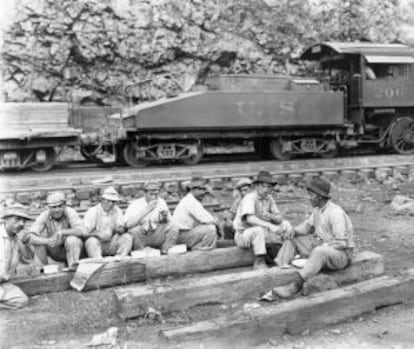Panama Canal: how the world turned up for the big dig
Spaniards and Italians made up majority of European workers in waterway’s construction 100 years ago

Spaniards and Italians led the pack of European immigrants who worked on building the Panama Canal 100 years ago. Today, Spain and Italy are again at the forefront in the current expansion work being undertaken at the canal.
Between 1904 and 1914, when the United States led the international effort to dig a waterway through the isthmus nation, some 8,298 Spaniards joined the work force along with 1,941 Italians. The highest number of foreigners came from Barbados, from where some 19,000 workers traveled to Panama to help in the big dig.
In all, 43,781 foreigners helped build the canal and today, the Grupo Unidos por el Canal (GUPC) conglomerate, which is undertaking the multi-billion-euro expansion effort, is led by the Spanish builder Sacyr and Italian construction firm Impregilo.
Because of the number of foreign-born workers who migrated to Panama a century ago, the Central American nation has become a cornucopia of cultures with Spanish taverns and Italian restaurants cropping up across the entire country.
“Immigrants saw Panama as a new beginning as economic opportunities arose in the isthmus nation,” wrote Vicente Barletta, a Panamanian journalist, in an article for El Faro, the official publication of the Panama Canal Authority (PCA). “If the capital of Panama had only about 20,000 residents in 1904, the construction area where the canal was being built was filled with immigrants – the majority of them from the Caribbean,” Barletta recalled.
Figures from the Roberto F. Chiari library at the PCA headquarters show that the majority of the foreign-born workers who came to Panama in the early part of the 20th century were from the Caribbean. After Spaniards and Italians, Greeks made up the third-largest group. There were only 19 workers who came from France, but 2,053 French citizens from the Caribbean island of Guadaloupe, which is a French overseas department, helped to dig the canal.
The Panama Canal will mark its 100th anniversary on August 15, the date on which it was officially inaugurated in 1914, just days after the start of World War I. It was considered a new wonder of the world.
The Americans controlled the canal until December 31, 1999 when, at noon that day, its operations were officially handed over to the Panamanian government. It was part of a long transfer process that began in 1977 when US President Jimmy Carter signed a treaty with then-Panamanian strongman Omar Torrijos.
Last month, GUPC threatened to abandon the expansion work on the canal unless the PCA advanced an additional $1.6 billion the group said was needed to pay for cost overruns. Expansion work, which has been budgeted at $5.250 billion, began in 2007 and is due to be completed by next year.
The PCA has rejected GUPC’s demands and said that the Panamanian government was abiding by the contract. Both sides are still at the negotiating table, trying to head off a January 20 deadline GUPC set for stopping the construction if it wasn’t paid.
On Tuesday, Manuel Manrique, Sacyr’s chairman, assured reporters at a news conference that GUPC “will not abandon” the project because the “only scenario on the horizon” is to hammer out an agreement with the PCA to resolve their financial discrepancies.
Spanish-owned Sacyr and the Rome-based Impregilo are majority partners in GUPC, each holding a 48-percent share. Jan De Nul of Belgium and Constructora Urbana of Panama are the other partners in the consortium with respective stakes of three and one percent.
Tu suscripción se está usando en otro dispositivo
¿Quieres añadir otro usuario a tu suscripción?
Si continúas leyendo en este dispositivo, no se podrá leer en el otro.
FlechaTu suscripción se está usando en otro dispositivo y solo puedes acceder a EL PAÍS desde un dispositivo a la vez.
Si quieres compartir tu cuenta, cambia tu suscripción a la modalidad Premium, así podrás añadir otro usuario. Cada uno accederá con su propia cuenta de email, lo que os permitirá personalizar vuestra experiencia en EL PAÍS.
¿Tienes una suscripción de empresa? Accede aquí para contratar más cuentas.
En el caso de no saber quién está usando tu cuenta, te recomendamos cambiar tu contraseña aquí.
Si decides continuar compartiendo tu cuenta, este mensaje se mostrará en tu dispositivo y en el de la otra persona que está usando tu cuenta de forma indefinida, afectando a tu experiencia de lectura. Puedes consultar aquí los términos y condiciones de la suscripción digital.
Últimas noticias
The complicated life of Francesca Albanese: A rising figure in Italy but barred from every bank by Trump’s sanctions
From digital curfews to blocking apps: How technology experts protect their children online
Why the price of coffee has skyrocketed: from Brazilian plantations to specialty coffee houses
Confined to a Cuban hospital: When electricity is a matter of life or death
Most viewed
- Pablo Escobar’s hippos: A serious environmental problem, 40 years on
- Why we lost the habit of sleeping in two segments and how that changed our sense of time
- Trump’s obsession with putting his name on everything is unprecedented in the United States
- The Florida Keys tourist paradise is besieged by immigration agents: ‘We’ve never seen anything like this’
- Charles Dubouloz, mountaineering star, retires at 36 with a farewell tour inspired by Walter Bonatti








































